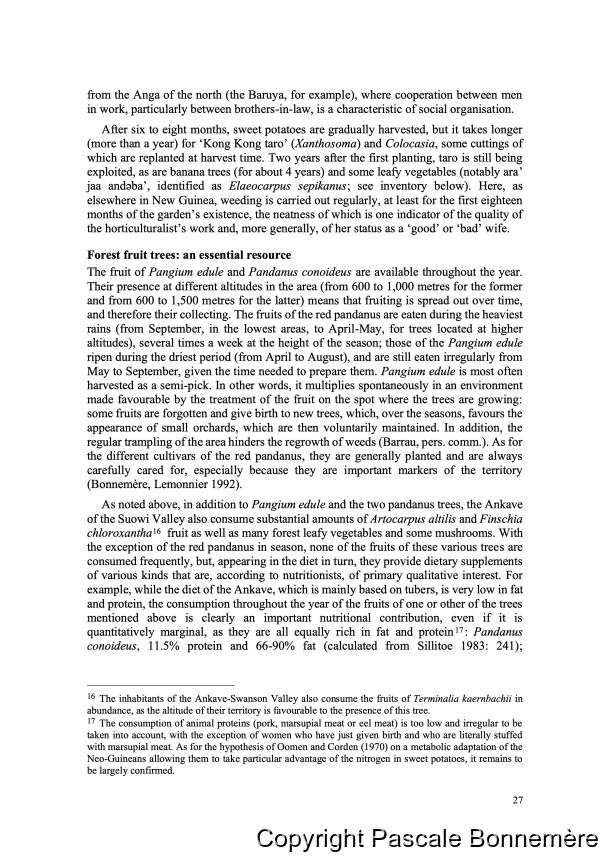|
|  [Note: this transcription was produced by an automatic OCR engine]
from the Anga of the north (the Baruya, for example), where cooperation between men
in work, particularly between brothers-in-law, is a characteristic of social organisation.
Afîter six to eight months, sweet potatoes are gradually harvested, but it takes longer
(more than a year) for ‘Kong Kong taro’ (Xanthosoma) and Colocasia, some cuttings of
which are replanted at harvest time. Two years after the first planting, taro is still being
exploited, as are banana trees (for about 4 years) and some leafÿ vegetables (notably ara”
jaa andoba’, identified as Ælaeocarpus sepikanus; see inventory below). Here, as
elsewhere in New Guinea, weeding is carried out regularly, at least for the first eighteen
months of the garden’s existence, the neatness of which is one indicator of the quality of
the horticulturalist’s work and, more generally, of her status as a ‘good’ or ‘bad’ wife.
Forest fruit trees: an essential resource
The fruit of Pangium edule and Pandanus conoideus are available throughout the year.
Their presence at different altitudes in the area (from 600 to 1,000 metres for the former
and from 600 to 1,500 metres for the latter) means that fruiting is spread out over time,
and therefore their collecting. The fruits of the red pandanus are eaten during the heaviest
rains (from September, in the lowest areas, to April-May, for trees located at higher
altitudes), several times a week at the height of the season; those of the Pangium edule
ripen during the driest period (from April to August), and are still eaten irregularly from
May to September, given the time needed to prepare them. Pangium edule is most often
harvested as a semi-pick. In other words, it multiplies spontaneously in an environment
made favourable by the treatment of the fruit on the spot where the trees are growing:
some fruits are forgotten and give birth to new trees, which, over the seasons, favours the
appearance of small orchards, which are then voluntarily maintained. In addition, the
regular trampling of the area hinders the regrowth of weeds (Barrau, pers. comm.). As for
the different cultivars of the red pandanus, they are generally planted and are always
carefully cared for, especially because they are important markers of the territory
(Bonnemère, Lemonnier 1992).
As noted above, in addition to Pangium edule and the two pandanus trees, the Ankave
of the Suowi Valley also consume substantial amounts of Artocarpus altilis and Finschia
chloroxantha!f fruit as well as many forest leafy vegetables and some mushrooms. With
the exception of the red pandanus in season, none of the fruits of these various trees are
consumed frequently, but, appearing in the diet in turn, they provide dietary supplements
of various kinds that are, according to nutritionists, of primary qualitative interest. For
example, while the diet of the Ankave, which is mainly based on tubers, is very low in fat
and protein, the consumption throughout the year of the fruits of one or other of the trees
mentioned above is clearly an important nutritional contribution, even if ït is
quantitatively marginal, as they are all equally rich in fat and protein!7: Pandanus
conoïideus, 11.5% protein and 66-90% fat (calculated from Sillitoe 1983: 241);
16 The inhabitants of the Ankave-Swanson Valley also consume the fruits of Terminalia kaernbachii in
abundance, as the altitude of their territory is favourable to the presence of this tree.
17 The consumption of animal proteins (pork, marsupial meat or eel meat) is too low and irregular to be
taken into account, with the exception of women who have just given birth and who are literally stuffed
with marsupial meat. As for the hypothesis of Oomen and Corden (1970) on a metabolic adaptation of the
Neo-Guineans allowing them to take particular advantage of the nitrogen in sweet potatoes, it remains to
be largely confirmed.
27
�
|